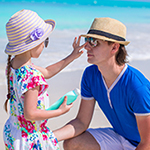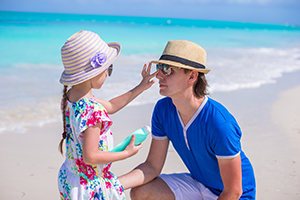
Latest news: 23 August 2017.

Researchers have highlighted the need to be vigilant about protecting children from the sun, after using data from the Sax Institute’s 45 and Up Study to emphasise that childhood sun exposure, rather than cumulative exposure, increases the risk of basal cell carcinoma in later life.
The research, led by the University of Sydney and 45 and Up Study major partner Cancer Council NSW, found that basal cell carcinomas (BCC) – which account for about 70% of all non-melanoma skin cancers diagnosed in Australia − were more commonly associated with sun exposure during childhood and adolescence, while cumulative sun exposure was found to be more important for squamous cell carcinomas (SCC).
The researchers investigated residential ambient UV as a risk factor for these two types of non-melanoma skin cancers in a sample of 45 and Up Study participants, including 916 people with BCC, 433 with SCC , and 1224 controls who had no skin cancer.
A rich Australian data resource
The 45 and Up Study is Australia’s largest and most valuable source of data on its ageing population. By linking health information from more than 250,000 Australians with other data sources the Study joins the dots on current health challenges so we can better understand and solve them.
The researchers who carried out this work are among hundreds of others who have used the Study to investigate important health questions. In this case, they geocoded lifetime residential locations to 74 years of age and used linked ambient UV data to calculate participants’ total UV exposure from birth. In addition, they used data on job history to assess time spent time working outdoors.
Their findings, published in the journal Photochemistry and Photobiology, showed that the risk of BCCs occurring on the head, neck and trunk was increased for higher ambient UV at birth, to 15 years of age and at 16−20 years of age.
People who had SCC had an increased risk of this cancer for lengthy outdoor employment, indicating long-term cumulative sun exposure.
The researchers said the study was the first to show that the risk of BCC, but not SCC, increased with high early-life residential UV exposure, in both in migrants and Australian-born participants.
“Our results reinforce the need for ongoing sun protection programs, especially in early life and sun-sensitive people” they wrote.
Findings used to reinforce sun protection message
Cancer Council Queensland highlighted the study finding in a media release, with CEO Ms Chris McMillian saying it reinforced the urgent need to miminise children’s exposure to UV radiation.
“Adequate sun protection is critical from an early age – with all five sun protection measures key to preventing this disease,” she said
“It’s critical that Queenslanders wear hats and have access to adequately shaded spaces when outdoors. Equally important, as guardians of our next generation we need to make sure our kids wear sunscreen, sunglasses and protective clothing when they are out at play, and we need to role model this behaviour to help normalise a SunSmart lifestyle.”
Find out more
- Read the study: Early Life UV and Risk of Basal and Squamous Cell Carcinoma in New South Wales, Australia (subscription required for full text access)
- Sign up to receive updates from the Sax Institute and 45 and Up Study
- Support the 45 and Up Study and other innovative Sax Institute work
